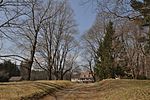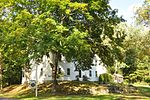Appleton Farms
1998 establishments in MassachusettsAppleton familyIpswich, MassachusettsOpen space reserves of MassachusettsParks in Essex County, Massachusetts ... and 2 more
Protected areas established in 1998The Trustees of Reservations

Appleton Farms is a park in Ipswich, Massachusetts, owned and maintained by The Trustees of Reservations. The property was deeded to the Trustees in 1998. The land was granted to Samuel Appleton, an immigrant from Little Waldingfield, England, in 1638 by the town of Ipswich and is one of the oldest continuously operating farms in Massachusetts. In 2002, The Trustees of Reservations established a vegetable Community Supported Agriculture Program. Also maintained by the Trustees of Reservations is the adjacent Appleton Farms Grass Rides. The properties include 4 miles (6.4 km) of walking trails.
Excerpt from the Wikipedia article Appleton Farms (License: CC BY-SA 3.0, Authors, Images).Appleton Farms
Waldingfield Road,
Geographical coordinates (GPS) Address Nearby Places Show on map
Geographical coordinates (GPS)
| Latitude | Longitude |
|---|---|
| N 42.6565 ° | E -70.845 ° |
Address
Waldingfield Road 3
01936
Massachusetts, United States
Open on Google Maps











